Apple's iPhone 4: Thoroughly Reviewed
by Brian Klug & Anand Lal Shimpi on June 30, 2010 4:06 AM EST- Posted in
- Smartphones
- Apple
- iPhone 4
- Gadgets
- Mobile
Screen - Retina Display
Right out of the box, the iPhone 4's new 326 PPI, 960x640, 3.5" display is arguably the single most striking change the new iPhone brings. In a word, it's dazzling. Text and high res images look amazingly sharp on the iPhone 4’s retina display. It’s an improvement over the 800 x 480 AMOLED screens that have been shipping on most Android phones. But if you’re comparing it to an iPhone 3GS the difference is huge.
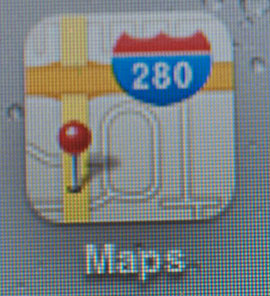 |
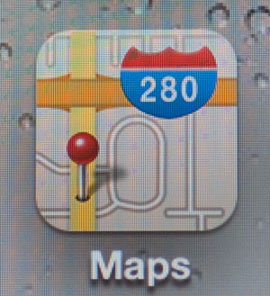 |
|
iPhone 3GS
|
iPhone 4
|

Text on the Google Nexus One

Text on the iPhone 4
The dot pitch is truly remarkable, so much so that Apple makes the claim that their display outresolves the human eye; its advertised ability to do so has earned it a new Apple tradename, "retina display."
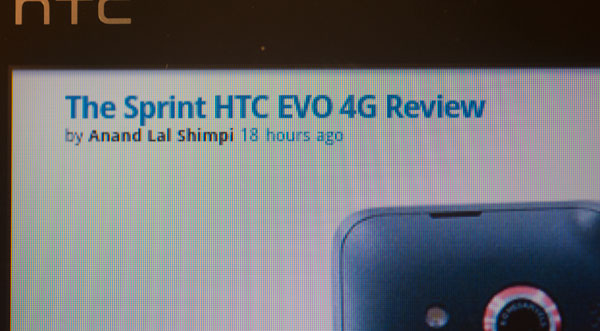
Text on the HTC EVO 4
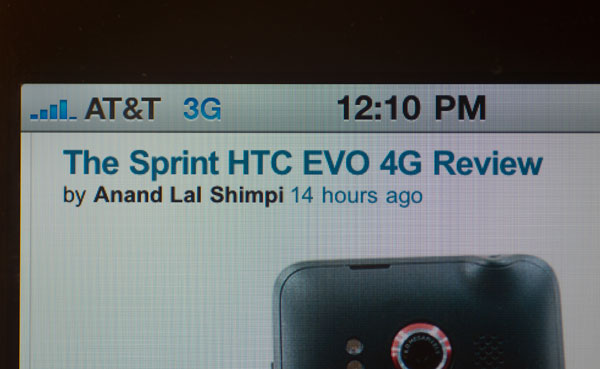
Text on the iPhone 4

AnandTech Logo on the EVO 4G

AnandTech Logo on the iPhone 4
Immediately after hearing Apple's claim that the Retina Display outresolves the human eye, I snapped into optics mode and crunched the numbers, and tweeted that the results were valid.
In the days that followed, there was considerable debate about the validity of Apple's claims. However, nearly all of the debate really just hinged on a debate over angular resolution of the human eye, and a little more over viewing distance. They're both entirely conventions.
As you've probably discovered by now, the human eye resolution can really only be characterized in angular subtense. Hold something closer to your eye, and you can see smaller features better (in theory), move it further away, and you can't make out small spatial details. The minimum angle visible with the human eye is the angle at which features (for the most common definition, a black and white square wave) stop being visible, and are indistinguishable from each other.
Most measures of visual acuity test with this implicitly - the Snellen eye chart's use of the capital "E" is literally a perfect example, which has given rise to a "tumbling E" eye chart. At twenty feet, the capital E subtends 5 minutes of arc, and conveniently has five half cycles of white to black (from top to bottom). So 20/20 implicitly implies an angular resolution of 1 arcminute (1/60 degrees).
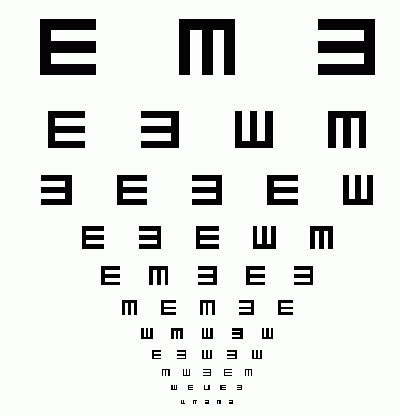
As an Optical Sciences and Engineering undergrad, I've had 1 arcminute drilled into my head more times than I can count as being the "normal" angular resolution of the human eye system. In practice, this is 20/20 vision, which is "normal," yet not perhaps the absolute maximum for human perfection. We can play games of course and argue that a small subset of the population has better than normal uncorrected vision, and thus an angular resolution of below 1 arcminute. I have above average uncorrected vision, which I've measured to be 20/15 on average, giving an angular resolution of approximately 0.75 arcminutes. Of course, the definitions stem from the spacing of cones in the fovea, the highest resolution part of the retina.
The other informational quantity needed to test the Retina Display claims is viewing distance. Again, there's a commonly agreed upon convention - standard viewing distance is considered to be 1 foot. This is another drilled into my brain number tossed around for comfortable viewing and reading. In practice, you can focus on objects much closer to your eye - this is called the near point and is often given as 10 inches, though as you get closer you increase strain aren't likely to keep it here.

Maybe not exactly the limit, but close enough.
Given the two most common standards tossed around, 1 arcminute and 12 inches, do the math out and you'll arrive at around 286 pixels per inch as the limit for eye resolving power, comfortably below the 326 on the Retina Display. Move to 0.75 arcminutes at 12 inches, and it's 382 pixels per inch, higher than the Retina Display. Honestly, I can't see the pixels at 12 inches.
Of course, the real story is even more complicated. Remember how the definition comes with the implicit assumption that we're dealing with a square wave pattern from white to black? That's a factor too - the contrast of the two pixels. Lower the contrast, and the eye's ability to pick out features decreases even more. So far, everything we've talked about has been first order, and without aberrations. Toss in spherical and astigmatism, two aberrations common to the eye system, and eye performance drops way more.
The human eye system is actually pretty poor, and shockingly easy to outresolve. In fact, if you saw the image your eye forms on your retina, you'd likely be appalled; it's your brain that makes the system usable. But at the end of the day, Apple's claims that the display outresolves the human eye are good enough for us.










270 Comments
View All Comments
macmanitou - Monday, July 5, 2010 - link
Hi Brian,great article, but one question just pops in my mind looking at the signal attenuation table, is the iPhone 3GS really the best? If yes I should really stick to it and probably just cancel the iPhone 4 order ;)
Sascha
isotropic - Monday, July 5, 2010 - link
Posted by: isotropic | 07/5/10 | 5:01 pm |This link Shows a Test phone TEMS sony/Ericsson K800i test phone (cost 2500+ Euro) being given the grip of death. A test done in a few minutes. It shows at a given point up to 16 dB losses by being held tightly as I have seen people doing it on the new iPhone. Not saying the iPhone could not have a problem, I don’t own one. But the iPhone is not alone for sure on this one. And Apple’s latest explanation seems pretty valid to me
http://www.youtube.com/watch?v=OWpGOxyEoZc&fea...
Akv - Monday, July 5, 2010 - link
I don't mind being locked in the Apple network for my iPod, because I find iTunes a quite convenient solution. However for a professionally strategic device like my cell phone, I would prefer a more independent solution.Besides, I still think it doesn't bring enough for the price. I could buy an excellent netbook for less than that price, and I would still have some money left for a simple but efficient clamshell phone.
ifartinyoutdirection - Monday, July 5, 2010 - link
It is a featurehttp://henriko.se/extern/iphone4buttonsandcontrols...
davehutch - Tuesday, July 6, 2010 - link
Your screen captures don't actually reflect what is being recorded. The video capture screen is a full-screen version that is not showing the correct ratio. the screen should be double-tapped for a tru representation and yes, the video angle of view is indeed smaller than the still image angle of view.please see my post here:
http://forums.macrumors.com/showpost.php?p=1044575...
for additional screenshots and comments.
r2d2droid - Tuesday, July 6, 2010 - link
Interesting. . . but I still want a droid.estarkey7 - Tuesday, July 6, 2010 - link
Why didn't you use Sprint's Everything plan pricing? For $99.00+$10.00 for the Evo 4g tax you get unlimited EVERYTHING, now add in tethering and see where that brings Sprint in comparison with AT&T and Verizon.Different ballgame all together, because 900 min is nothing. I talk 1200+ every month.
RadioGuru - Tuesday, July 6, 2010 - link
Hello guys. Thanks for the review. I have a quick question. Your wrote that "To generate these numbers, I measured at least 6 times and took the average"I wonder, did you convert the dBm number to linear, took the average and the recalculated the numbers back to dBm, or took the average using the dBm values. If you did the later, the numbers are completely wrong.
Your testing is better than most of what I have seen online so far, but real engineering testing has revealed that the TIS (Total Isotropic Sensitivity) of iPhone4 in Free Space is better than the 3GS, which is great!!!! but.....and here comes the big but....phamtom head testing of WCDMA 1900 TIS/TRP spec testing has shown a degradation of close to 30 to 40 dB in chamber testing. Which means a controlled lab environment...not a cowboy lab testing like the one you used. Sorry, I respect your work and I support what you do...but this time of evaluation requires far more engineering power.
in WCDMA/HSDPA systems, a call dropped is usually driven by reverse link limitaiton. Therefore engineers also consider TRP (Total Radiating Power) to measure antenna performance. in the case of iPhone4, TRP degradation due to HAND+HEAD is close to 40 dB, which will kill the call or increase drop calls or reduce data througput performance.
By the way, BAR maping using SNR makes sense for HSDPA data calls. GSM calls should use RSSI.
jacobdrj - Thursday, July 8, 2010 - link
You rock.dalebeal - Friday, July 9, 2010 - link
This is the most comprehensive review I have read - and I've read a lot of them. Thank you!